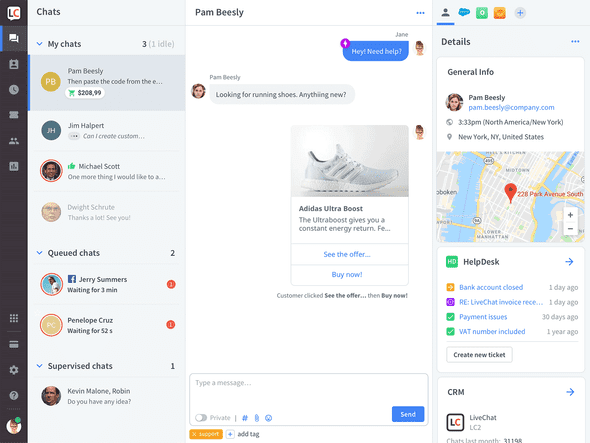Those of you who’ve been using LiveChat long enough know it’s been evolving. You may have, for example, experimented with the new view turning it on and off. Other improvements allow for handling online conversations, viewing chat history, or integrating external apps. Today, we’d like to summarize what exactly has changed over time and what these changes mean for the LiveChat users.
In general, the improvements concern three main areas:
- the Messaging Protocol
- the Agent App
- the Chat Widget
The Messaging Protocol is the very core of the LiveChat product, so let’s jump straight to it!
The Messaging Protocol
The Messaging Protocol describes an entire conversation. It is the common language for the Agent App, the Chat Widget, and the backend infrastructure. It defines the structure of messages and events, transport (how data is sent), and participants (who can send and receive data).
Here’s what Karolina, the Product Manager of LiveChat, says about switching to the new protocol:
Preparing the new protocol required a lot of work. However, it opened up a lot of possibilities that fit in nicely with our product > vision – making LiveChat useful across entire companies, and not just for the support or sales teams.
Real-time Transport
Thanks to the websocket-like connection type, real-time transport is possible. What’s important, customers can send messages, no matter if agents are online or offline - messages will still be delivered. That’s a huge milestone, as LiveChat has not always allowed for it.
New Data Types
Apart from standard plain-text communication, the new protocol supports rich messages (RM). They not only make the whole chatting experience simpler, but also more pleasant and engaging. You can read about different RM types in this article. See our documentation for more technical details.
Protocol Open to Integrations
Previously, the protocol was closed. There was no easy way to intercept the message on the fly or to participate in the conversation. Our new APIs are open, which means you can easily build LiveChat integrations that join conversations. What’s more, integration with tools such as Facebook Messenger is now feasible.
The Agent App
When it comes to the Agent App, not only was is redesigned, but also numerous functional possibilities were enabled.
Redesign with a Capital R
Changes in the LiveChat UI were inevitable if we wanted our application to grow and expand. The process has recently finished, but for a long time we were maintaining two views. It’s because we wanted everyone to be getting used to the new design at their own pace.
Chat History Always at Hand
One of the limitations of LiveChat was that it didn’t allow to scroll up for chat history. Well, those days are gone. Right know, a chat consists of threads, which receive events. There’s always one active thread open, and if not - let’s say it was closed due to inactivity - an incoming event will start a new thread and the whole conversation will continue. There won’t be any gaps in the users’ chat history. We’ve explained that in this document, so make sure to check it out.
Chat Widget
Similarily to the Agent App, the Chat Widget supports not only standard text messaging, but also rich messages and Moments . Not sure if Moments would be of any use? Make sure to check out this blog post!
The changes in our APIs opened doors to building new apps. You could create some integrations for advanced reporting, custom metrics, or workflow automation.
Need some ideas? Want to begin your journey but not sure how? Check out our guides or go straight to Developer Console. In case of any doubts, you can reach us at developers@livechat.com!

